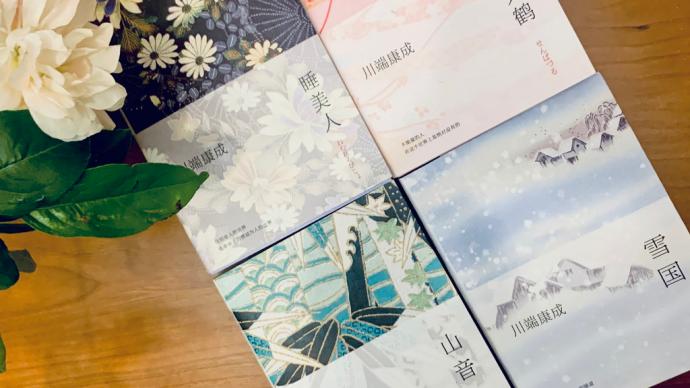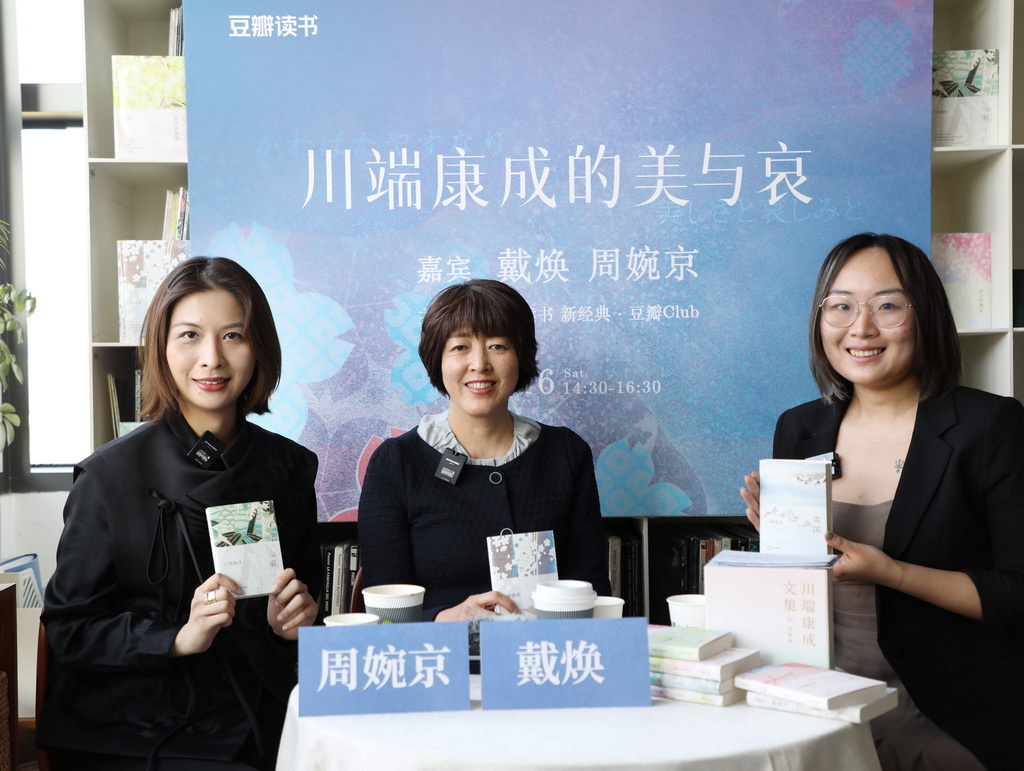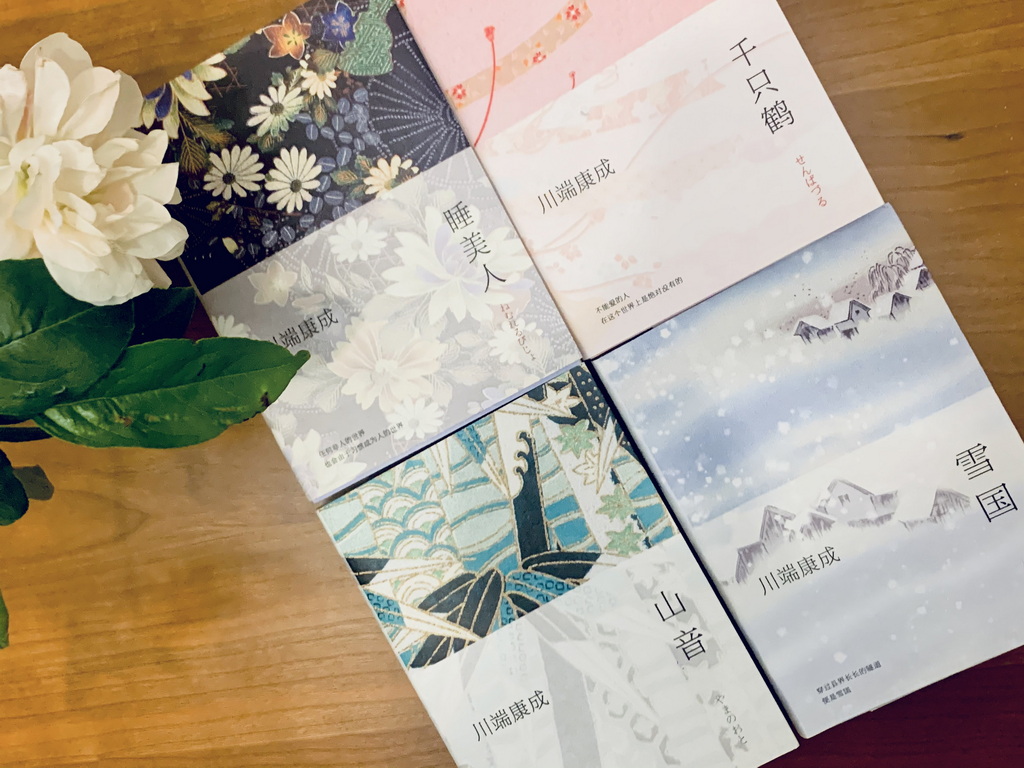

On-site dialogue.
2022 is the 50th anniversary of the death of the Japanese writer Kawabata Yasunari. Recently, Dai Huan, a scholar and translator of Japanese modern literature and a teacher of the Japanese Department of Renmin University of China, Zhou Wanjing, a young writer, art critic, and a teacher of the Beijing International Studies University, and Kawabata Yasunari collected works. Editor-in-Chief Xu Yanwen had a dialogue on the theme of "Kawabata Yasunari's Beauty and Sorrow".In 1968, Yasunari Kawabata became Japan's first Nobel Prize winner for literature with three works representing the pinnacle of Japanese aesthetics - "Snow Country", "Ancient Capital" and "Thousand Cranes". The Nobel Prize judges commented that he "expressed the essence of the Japanese soul with extraordinary sharpness and superb novel skills" in the award speech. Kawabata Yasunari also had a profound influence on several generations of Chinese writers including Yu Hua and Mo Yan. Today, Kawabata's works are still widely read around the world.
"Snow Country" and the Beauty of Nothingness
There is a passage in "Snow Country":
The crepe was tied with a card bearing the name and address of the weaver girl, and graded according to her grades. This is also the basis for choosing a daughter-in-law. If I didn't learn to weave from a young age, I would not be able to weave high-quality crepe at the age of fifteen or sixteen, or even twenty-four or five years old. As people get older, the woven fabrics lose their luster. Perhaps it was because the girls worked hard to train their skills in order to squeeze into the ranks of the first-class female textile workers. They started reeling silk in October of the old calendar and finished drying in mid-February of the following year. He can do anything, so the handwork is particularly fine, and all the love is poured into the product. To this day, Shimamura still takes his crepes for "snow drying". ...with the authentic exposure method. The morning light splashed on the white linen crepe exposed to the thick snow, and whether it was snow or crepe, it was dyed a beautiful red.

Book shadow.
Zhou Wanjing believes that this passage well reflects Kawabata Yasunari's attention to the countryside. The Little Master Island Village in "Snow Country" represents urban culture. The scene is a typical rural situation, and Kawabata looks at rural landscapes such as "Snow Sun" with respect and appreciation.Kawabata Yasuji himself is a filter. He filters the memories that he has piled up, and he also reflects on himself. Shimamura in "Snow Country" is also the incarnation of Kawabata himself. Shimamura likes to think. "Snow", Shimamura has a very wonderful saying, he said: "Among the crepes I wear, there may be girls from the late Edo period to the early Meiji period." The crepe exposed to the thick snow, "Snow Country" is full of a vain beauty and fragility.
Dai Huan mentioned that the most impressive content in "Snow Country" is the passage called "Mirror of Twilight":
The twilight scene moved behind the mirror. That is to say, the virtual image reflected by the mirror and the real thing behind the mirror are shaking, just like the overlapping images in the movie. There is no connection between the characters and the background. Moreover, the characters are a kind of transparent illusion, and the scenery is a hazy undercurrent in the night mist. The two melt together to describe a symbolic world that is beyond the world. Especially when the lights in the mountains reflected on the girl's face, the indescribable beauty made Shimamura's heart almost tremble.
In the sky above the distant mountain tops, there is still a faint afterglow of the sunset. The outline of the scene seen through the window glass, receded into the distance, did not disappear, but was eclipsed. Although the train continued to move forward, Yamano's ordinary gesture seemed more ordinary to him. Since nothing caught his attention very much, there seemed to be a huge emotional torrent in his heart. This is naturally due to the girl's face appearing in the mirror. Only the part of the figure reflected on the window glass obscured the twilight scene outside the window, but the scene kept moving around the silhouette of the girl, making it seem that the girl's face was also transparent. Is it really transparent? This is an illusion. For the twilight that kept passing behind the girl's face seemed to flow in front of her. Look closely, but bewildered.
Lin Shaohua believes that this passage embodies the beauty of nothingness advocated by Yasunari Kawabata. "The beauty is like the image in the mirror on the window glass of a night train. It is uncertain, mobile, instantaneous, and may be destroyed at any time." Dai Huan believes that this movie-like passage foreshadows the technique and structure of the entire novel in "Snow Country", implying that Shimamura's inner world is not the real world, but has strong sensibility.
Xu Yanwen believes that the beginning and end of "Snow Country" are very classic. At the beginning, Shimamura took a train through a long tunnel and came to a white snow country. "The appearance of the tunnel image symbolizes entering another artistic conception. In the novel, Shimamura was led to a mysterious world by two girls. At the end of "Snow Country", there is a wooden house in the vast snow, and it suddenly caught fire. At this time, Ye Ye should have died. The scene where the body of the leaf falls from above, this scene is really beautiful, and there is a feeling of determination that doesn't match Kawabata's impression in my heart."
In Japanese novels, Yukio Mishima is the representative of "resolute". For example, "The Kinkakuji" finally burns the Kinkakuji. In "Snow Country", when the leaves fell from the second floor of the burning wooden house, critics also believed that the leaves were a symbol, representing that a pure and very beautiful thing like the Kinkakuji must be destroyed.
 Who influenced Yasunari Kawabata
Who influenced Yasunari KawabataKawabata Yasunari was a very active figure in the literary circle of his era. Scholars also shared their views on who influenced Kawabata Yasunari and who Kawabata influenced.
Zhou Wanjing believes, "It is clear that the authors of the previous generation of Kawabata were more aesthetically pleasing, such as Nagai Hefeng. Why did Kawabata choose to write about the countryside instead of the city? Because the urban development is faster than the countryside, the countryside has been preserved and the Japan of the past has been suspended. , Kawabata looks for the roots of Japanese culture. In addition, writers of the era such as Tanizaki Junichiro, Kawabata, Mishima are also re-reading "The Tale of Genji", Kawabata's concept of the "flowering period" of women is also inherited from "The Tale of Genji" ."
But compared to the straightforward local roots, Kawabata Yasunari writes about people and things, and pays more attention to memories and feelings. Dai Huan took the short story "Water Moon" as an example. In this story, Kawabata tells how a mirror brings happiness to a couple in need. In the story of "Shuiyue", the husband is sick in bed, and the wife takes a small mirror to the husband. Through the mirror, the husband can see the outside world and his wife in the vegetable field. While the wife is working in the vegetable field , they will realize the loving gaze of the husband, and the wife will also look at the world through the mirror with her husband. Slowly, they will not be able to distinguish the world they see with their naked eyes from the world they see in the mirror, while the mirror The middle world is more like a new world they created together with the eyes of love, including the novel that they saw the moon reflected in the water through the mirror.
The moon in the water, the fleeting cherry blossoms, the Japanese do not like to express their feelings with abstract and systematic theories, they like to express their thoughts with perceptual literary works. "So when reading Kawabata Yasunari, what stories are told in his works is not the most important thing, but what you feel is important. At the same time as you feel, you will feel nothingness, but it is precisely because of nothingness that you have to grasp it even more. Beautiful." Dai Huan said.
In addition to these extreme beauty, Kawabata's works seem to have some ugly changes in writing. For example, in "Thousand Cranes", there is a large black mole on the chest, and there are also indifferent or distorted male protagonists in "Izu's Dancing Girl" and "Snow Country". Dai Huan believes: "Although Kawabata's writing seems to be an ugly thing, due to the magical logic in it and the transformation and reshaping of the characters through viewpoints, the last ugly thing can always bring some good things. In Kawabata's works There is always a process of transformation, for example, in "The Dancer of Izu", the character of 'I' is distorted, but through a period of contact with the little dancers and wandering entertainers, I will eventually be released or get some kind of healing."
Dai Huan also pointed out that Kawabata Yasunari’s other noteworthy point is his attention to the life of the underclass, and there are not many intellectual writers in the history of modern Japanese literature who write about the life of the underclass. Higuchi Ichiyo is involved. Kawabata's observation of the people at the bottom and the description of their living plight is very precious. I recently read Yu Dafu's "Night in the Spring Breeze", and I think the two of them are very similar. , the tone of the whole work is that kind of faint sadness, but it also expresses the plight and small joy of people living at the bottom."
Related Posts